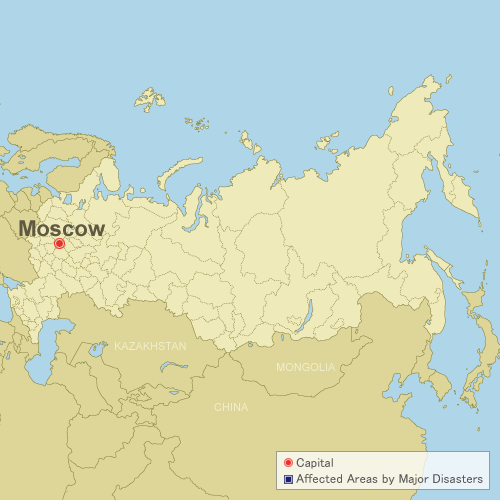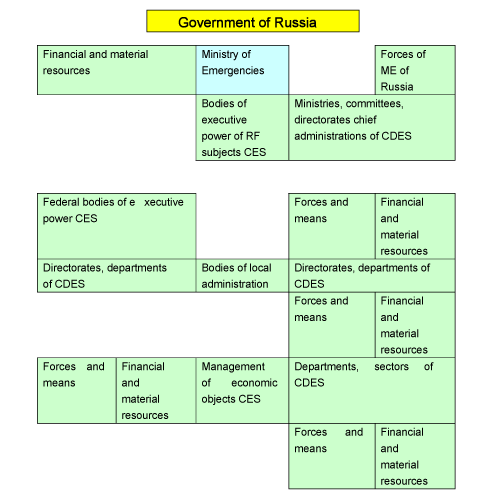TOP PAGE > Information on Disaster Risk Reduction of the Member Countries
Information on Disaster Risk Reduction of the Member Countries
 Russian Federation (the)
Russian Federation (the)
General Information
 Formal Name: Russia
Formal Name: RussiaRussia has the largest land in the world that extends from the Baltic Sea to the Pacific Ocean. Most of the 17.1 million square kilometers of land is covered with vast plains, with steps in the north and taiga in the south. In the high-latitude area, the tundra zones spread where no trees can grow. Gory Kavkaz is located near the south border between the Black Sea and Caspian Sea, and the Ural Mountains is located between the border of Asia and Europe. The climate is very different from region to region, from subtropical climate to the polar climate. Day-night temperature difference is also fierce.
Moscow is the capital. Population is 146 million (Jan. 2017). Majority are the Russian with different ethnic groups.
Overview of Disasters
Most of Siberia consists of permafrost, which causes floods in spring and forest fires in summer and fall. The Peninsula of Kamchatka is prone to volcanic activity and earthquakes. Drought, extreme temperatures, landslides, and wind damage may cause damages.
Recent Major Disasters
Sakhalin Earthquake (May 1995)
On 28 May 1995, there was an earthquake measuring M7.7 in the north Sakhalin which killed 1,989 people.
Flood (June 2012)
On July 2012, heavy rains hit the Krasnodar region in southern Russia, causing floods. 172 people were killed, 34,650 people were affected and 7,200 houses collapsed due to flood damage.
Wild Fires/Heatwave (July 2010)
On July 2010, more than 20 regions of the Russian Federation had around 30,000 wild fires, following the effects of a heat wave at 40 degrees Celsius and killing more than 50 people. Many rural settlements (approximately 2,200 houses) in part of Europe Russia, the Ural Mountains and Western Siberia have been burned down by fire.
Disaster Management System
Legal System
Several laws and policies were enacted by the Government of Russia to protect its people during emergency situations. These include: Law of the Russian Federation On Safety (March 5, 1991); Presidential Decree (PD) No. 794 (December 30, 1992); Federal Law (FL) No. 68 on “Protecting the Population and Territories from Emergency Situations” (December 21, 1994); and FL No. 3 on “Emergency-Rescue Services and Status of Rescue Personnel” Order of the Ministry of Emergencies of Russia No. 200 (April 21, 2003) provided for the basic roles and functions of the Ministry of Emergencies.
Organization
 The national structure for coordinating and executing disaster risk reduction is the single state system of preventing and eliminating emergency situations (RSES), which was established in 1992. It integrates management bodies, forces, federal bodies, local administrations and organizations to protect population and territories from emergency situations.
The national structure for coordinating and executing disaster risk reduction is the single state system of preventing and eliminating emergency situations (RSES), which was established in 1992. It integrates management bodies, forces, federal bodies, local administrations and organizations to protect population and territories from emergency situations.Ministry of Russian Federation for Civil Defense, Emergencies and Elimination of Consequences of Natural Disasters is responsible for the implementation of disaster management policies.
Plan
Planning of actions for emergency situations is carried out at all levels of the RSES system which includes: Federal plan of actions, regional plans of actions (cooperation); plans of actions of federal executive bodies (functional subsystems); plans of actions of executive bodies of subjects of Russian Federation (territorial subsystems), as well as plans of actions of local self-management; authorities and plans of actions of organizations (objects).
On January 2018 the President approved “the Basics of the Russian Federation State Policy on Protection the People and Territories from Emergency Situations until 2030”. It is indicated the basic direction of disaster and emergency measures to be implemented by 2030, such as the early detection of dangerous natural phenomena for global climate change and natural disasters, and consideration of risk-based countermeasures.
On January 2018 the President approved “the Basics of the Russian Federation State Policy on Protection the People and Territories from Emergency Situations until 2030”. It is indicated the basic direction of disaster and emergency measures to be implemented by 2030, such as the early detection of dangerous natural phenomena for global climate change and natural disasters, and consideration of risk-based countermeasures.
ADRC Counterpart
Country Report
Country Report 2006 (Japanese Version, PDF file)Country Report 2006 (English Version, PDF file)
Country Report 2003 (English Version, PDF file)
Country Report 1999 (English Version, PDF file)
Country Report 1999 (Japanese Version, PDF file)
Country Report 1998 (English Version, PDF file)

